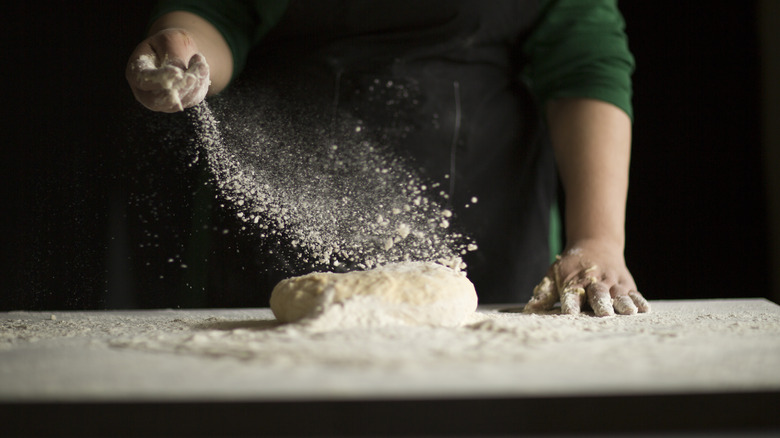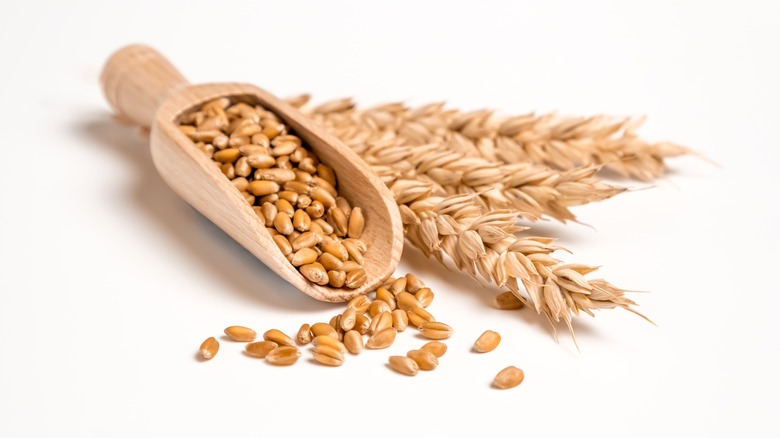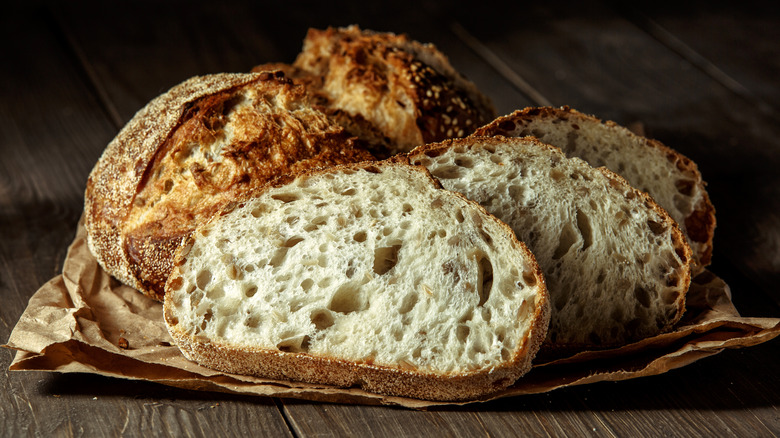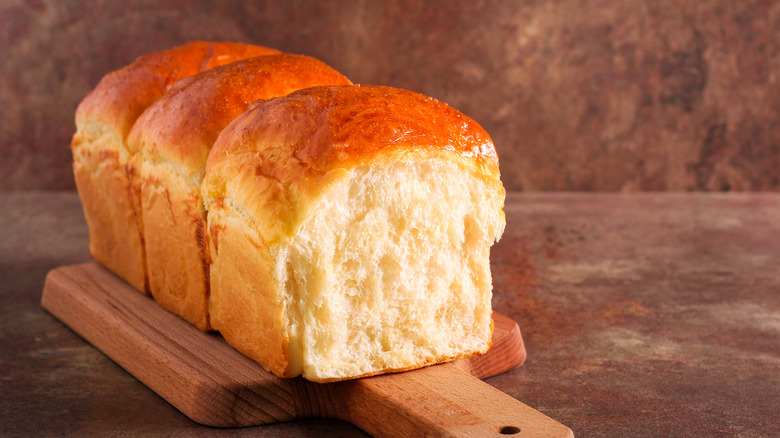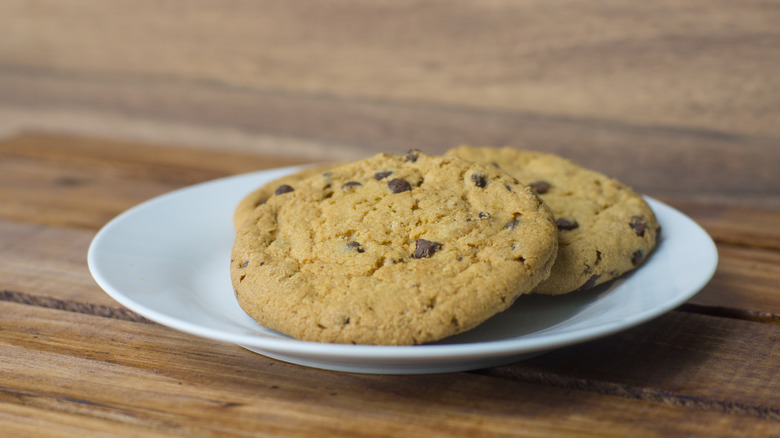How Bread Flour Actually Affects Your Baked Goods
Most of us have a bag of all-purpose flour sitting in our pantry right now, but can it really be used for all purposes? It wouldn't seem so, judging by bread recipes, which almost always call for bread flour. If you're new to baking bread, there's a slim chance you'd have this variety on hand, and you might wonder if you really need it all. On sight, bread flour looks no different from all-purpose flour, and they typically cost exactly the same, so how much of a difference could substituting one for the other make? Quite a big difference, it turns out. Bread flour is the key to achieving the perfect chewy crumb and crackly crust that we crave in sourdough loaves, French baguettes, and pizza crusts.
You might have heard that bread flour contains more gluten than all-purpose flour, but this isn't entirely accurate. Raw flour doesn't actually contain any gluten. Instead, it contains two types of protein called glutenin and gliadin. When you add water to flour, the glutenin and gliadin bond, forming gluten. Bread flour contains more of these proteins than most other types of flour, which means it will produce more gluten when water is added. This makes a world of difference for the texture of bread, but it can also be a bad thing for other baked goods. Know the strengths and weaknesses of bread flour, and you'll open a new world of possibilities in the kitchen.
How is bread flour made?
Flour can be made from almost any type of grain, from rye to spelt to corn and beyond, but bread flour is only made from wheat berries. It belongs to the broad category known simply as "white flour," which also includes all-purpose flour, cake flour, and pastry flour. All of these white flours are made from the same part of the wheat berry. Wheat berries have three components: the bran, which is the hard outer shell; the germ, which is the small, seedlike embryo of the wheat; and the endosperm, a layer of starch and protein that lies beneath the bran. White flours contain only the finely-ground endosperm, which makes it soft but also less nutrient-rich.
The difference between bread flour and other varieties is that they are made from different types of wheat. There are about 30,000 varieties of wheat, but they can be grouped into six broader classes: hard red winter wheat, hard red spring wheat, hard white winter wheat, durum wheat, soft white winter wheat, and soft white spring wheat. Hard wheats contain more proteins than soft wheat, which means they can form more gluten. All-purpose flour is milled from a combination of hard and soft wheats, with a protein content from 9-11%, but bread flour is milled from hard wheat only, giving it a protein level from 11-13%. Cake and pastry flours range from 8-9% protein, ensuring minimal gluten development. With bread, you want the opposite.
Why is gluten so important for bread (and bad for other baked goods)?
So, why do we care so much about how much gluten we can form in the first place? Well, gluten is basically the skeleton that gives a loaf of bread its structure. When you mix water and flour, glutenin and gliadin proteins bond to form strands of gluten. Then, as you work the dough, those gluten strands link up with each other and form a mesh-like network. That tangled-up web of gluten traps the gas released by yeast; without it, the dough could not rise properly. After shaping your loaf, those long strands of gluten act like a scaffold, maintaining the structure of the bread as it bakes and cools. There's also a significant textural element at play, as gluten strands create the chewy texture we look for in crusty breads.
While gluten development is essential for bread-baking, it's actually a major obstacle for other baked goods. Think about baking a cake, which should have a soft, velvety texture and very small air bubbles throughout. This requires minimal gluten development, so bread flour shouldn't be used to make cake. In pastries, you need a little bit of gluten development for the dough to have structure, but too much gluten will make it too stiff to roll. Once again, bread flour shouldn't be used for this purpose. Each type of flour — bread, cake, pastry, and all-purpose — has a unique function and should be used accordingly.
Do all types of bread require bread flour?
You don't necessarily need bread flour to make bread. It all depends on the style of bread you are making and the texture that you're aiming for. Use bread flour when you are making chewy breads such as sourdough, bagels, pretzels, or pizza dough. With these breads, you really want the crumb to have a springy, chewy texture, and it takes a strong gluten network to achieve that.
On the other hand, if you are baking a style of bread that has a soft, pillowy texture such as brioche, challah, Hawaiian roll, or milk bread, you only want moderate gluten development. In these breads, you want to see a tight crumb with an even distribution of small air bubbles, not big pockets of air like you find in a baguette or batard. It's best to make them with all-purpose flour, whose blend of soft and hard wheats gives it the perfect, middle-tier protein content.
Substituting bread flour and all-purpose flour
Now, let's say you want to make a loaf of bread, but you don't have any bread flour in your pantry; are you helpless? Thankfully not. It's always best to use the exact type of flour that a recipe calls for, but it is possible to substitute all-purpose flour for bread flour in certain instances. Generally speaking, you can substitute bread flour with an equal amount of all-purpose flour in most bread recipes. If you're going to do this, it is best to use unbleached flour, as the bleaching process softens the glutenin and gliadin proteins. You can also make up for some of the protein loss by giving your bread a cold ferment — that is, rising overnight in the refrigerator. A slow ferment allows for more gluten development.
You can substitute all-purpose flour for bread flour, but you shouldn't substitute bread flour for all-purpose flour. If you use a high-protein flour in your batch of pancakes, they will be stiff and chewy rather than soft and fluffy. There is one exception to this rule, however. If you're a fan of chewy cookies, try using bread flour in place of all-purpose the next time you make chocolate-chip cookies or snickerdoodles.
